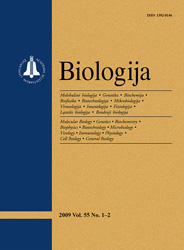Biologija / Biology
 ISSN 1392-0146 ISSN 2029-0578 (online) |
2006 m. Nr. 3 Influence of 1,4-dihydropyridine derivatives on rat
paw edema, biosynthesis of glucocorticoid hormone
and its binding activity to glucocorticoid receptor
The influence of the 1,4-dihydropyridine derivatives OSI-7725 and OSI-7727 on acute inflammation, glucocorticoid hormone (GH) synthesis and specific GH binding to glucocorticoid receptor (GR) activity was investigated. Since several 1,4-dihydropyridines (DHPs) possess anti-inflammatory properties, we first studied the effect of racemate OSI-7725 and its (+) enantiomer OSI-7727 in a model of rat paw edema induced by carrageenan. These compounds had a preventative effect in this model of inflammation and decreased edema development at a most effective dose of 0.1 mg/kg by 26.6% and 41.6%, respectively. Both compounds were ineffective when added after carrageenan injection. Subsequent experiments in vivo showed that OSI-7725 and OSI-7727 at a dose of 5 mg/kg stimulated GH synthesis in rat adrenal. They induced an increase in total, transcortin-bound and free corticosterone levels in plasma 2 h following intraperitoneal administration. The pretreatment with metyrapone, an inhibitor of steroid synthesis, abolished the stimulatory effects of the compounds tested, indicating a steroidal component in the mechanism of action of DHPs. Further experiments in vitro showed that these DHPs inhibited dexamethasone (DEX) binding to GR. More active in this model was OSI-7725. It inhibited specific ligandreceptor binding by 80% at concentrations 10–5 and 10–4 M. OSI-7727 was active only at a concentration of 10–4 M. IC50 values of these compounds were 3.59 and 5.52 μM, respectively. The results show a significance of these DHPs in the regulation of vitally important processes and provide an evidence of involvement of fine mechanisms through which the pharmacological effects of DHPs can be released. This could extend the potential of the application of these substances.
Keywords: 1,4-dihydropyridine, glucocorticoid hormone, glucocorticoid receptor |
Issues:
2011 - Vol.57 No. 1, No. 2, No. 3 2010 - Vol.56 No. 1-4 2009 - Vol.55 No. 1-2, No. 3-4 2008 - Vol.54 No. 1, No. 2, No. 3, No. 4 2007 - Vol.53 No. 1, No. 2, No. 3, No. 4 2006 No. 1, No. 2, No. 3, No. 4 2005 No. 1, No. 2, No. 3, No. 4 2004 No. 1, No. 2, No. 3, No. 4 2003 No. 1, No. 2, No. 3, No. 4 2002 No. 1, No. 2, No. 3, No. 4 2001 No. 1, No. 2, No. 3, No. 4 |